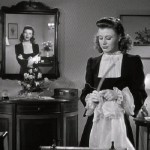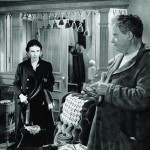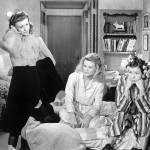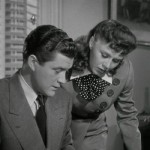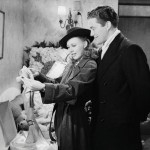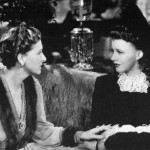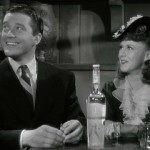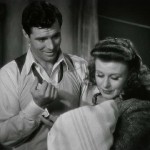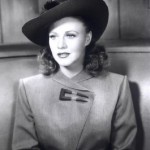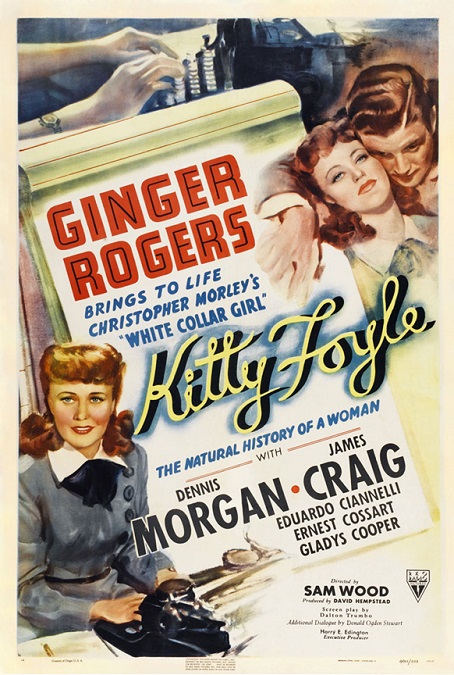
Kitty Foyle – 1940
I knew next to nothing before going into this movie and I was pleasantly surprised by two things in particular. First was the wonderful performance of Ginger Rogers in the title role of Kitty Foyle. Second was the mature nature of the plot. This was a movie that had several prominent themes, one of which was the role of a new kind of person in the 1930s, the single working woman.
The film started off with a cute but insightful little bit about how women were treated around the turn of the century. They were, in general, attractive things to be put up on pedestals. Men would stand when they walked into the room and offer them their seats on the trollies. They would marry them and take them to a house which they would have little reason to ever leave except to shop and visit with their other female friends.
But as the world progressed, things changed. No longer did men treat them as ladies, but as women, if I might make the subtle distinction. Women became independent and wanted to be treated as equals, and they got what they wanted. They were ignored on the bus and nobody stood when they entered a room.
Kitty Foyle was a woman from a lower class family who got a white collar job to take care of her aging father. But though she was good at her job, I noticed that she still held the position of the secretary, the subordinate role. The gender and class roles in the workplace were more equal than they had been in the past, but still not truly equal. And she dealt with a problem that any modern viewer can clearly see still exists today. She was treated as a sexualized object by her male boss, in this case, Wyn Stratford VI, played by Dennis Morgan.
And though women, in general, were moving away from the idea that a husband was necessary for a successful life, it was a notion that was still rather prominent. A great quote from the film which epitomizes the idea is this: “What’s the difference between men bachelors and girl bachelors? Men bachelors are that way on purpose.” Even though Wyn treated Kitty in a way that would be considered blatant sexual harassment in today’s world, she allowed it and even said yes when he asked her out on a date.
Now, here is where the movie took a bit of a left turn. It began to focus not on the position of the working woman, but on the difficulties of Kitty’s romantic life. Wynn loved her but could not be seen with her around Philadelphia, where his snooty upper-class family and friends lived. And the film took it in an interesting direction. Wyn loved her enough to actually defy his family and marry her. He was actually ready and willing to give up his life of privilege and all his wealth, and move to New York to be with her. But she knew that to do so would make him unhappy, so she left him, choosing to be alone rather than forcing him to give up his inheritance.
She meets a common man, Dr. Mark Eisen, played by James Craig, who is as poor as her, but who falls hopelessly in love with her. She doesn’t seem to love him at first, but she continues to see him. Well, you can see how the plight of the single working woman in society has nearly been forgotten, overshadowed by the Hollywood love triangle. Will she end up with the man she loves or the man who loves her?
Rogers was incredibly good and she actually won the Academy Award for Best Actress that year. Most people know her from her dance musicals and her association with Fred Astaire. But here she proved that she was even more talented an actress than anyone knew. She was particularly good in portraying the character’s pregnancy and the stillborn child.
The two men, Morgan and Craig, did just fine, but in my eyes, they were both overshadowed by Rogers. Morgan was very handsome and had an adorable smile. Kitty’s two roommates, played by Mary Treen and K. T. Stevens, were there for a bit of comic relief and also to help illustrate the difference in the social classes between Wyn’s upper-class lifestyle and Kitty’s lower class one.
This was a good movie and I enjoyed watching it. Rogers was a delight to watch, proving that she was much more than just a good dancer. She truly was a Hollywood starlet and a darn good actress.
